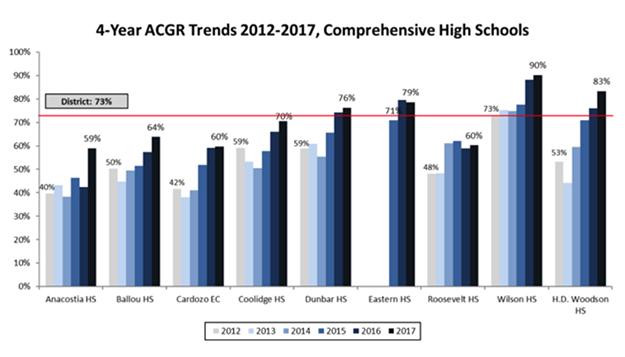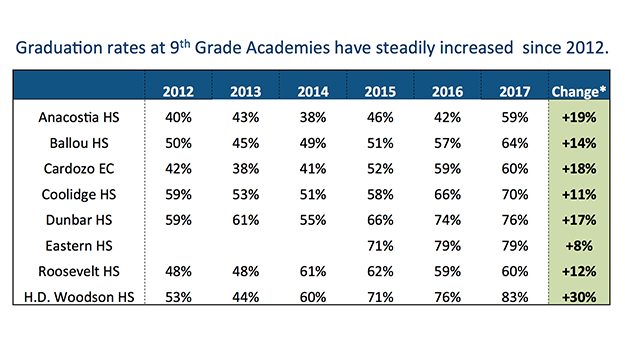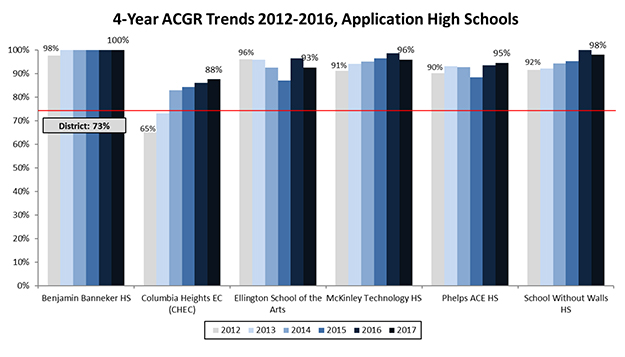(Washington, DC) – The percentage of DC Public Schools students who are graduating in four years increased to 73 percent, an increase of 4 percentage points since 2016 and 20 percentage points since 2011.
“DC Public Schools is thrilled to see six continuous years of progress with rising graduation rates,” said Chancellor Antwan Wilson. “DCPS has made great strides in the last few years to prepare students for postsecondary success, including expanding AP courses, increasing access to dual enrollment opportunities, and placing students in paid internships.”

“Ten years ago, our city committed to giving all students a fair shot at success, and today, these historic graduation rates are more proof that our efforts and investments are paying off,” said Mayor Muriel Bowser. “Since initiating the reforms that turned DCPS into the fastest-improving urban school district in the country, we have made unprecedented investments in the modernization of our buildings, overhauled the way teaching and learning happens in our schools, and built a system that truly values and prioritizes collaboration between schools and families.”
Nearly all comprehensive high schools increased their four-year graduation rate over the previous year, including Anacostia High School (increasing 17 percentage points), Ballou High School (increasing 7 percentage points), and Woodson High School (increasing 7 percentage points). In School Year 2016-2017, these schools piloted the College and Career Coordinators program, which has expanded in School Year 2017-2018 to include Coolidge High School, Cardozo Education Campus, Dunbar High School, Columbia Heights Education Campus (CHEC), Eastern High School, and Roosevelt High School. College and Career Coordinators ensure that all students have plans for high school and beyond, more exposure to college via tours and expos, and assistance with SAT prep and FAFSA completion.

This year is the first year of graduates who participated in 9th Grade Academies, a strategy to support 9th graders as they navigate the rigor of high school. The comprehensive high schools with 9th Grade Academies have seen steady progress on promotion rates and graduation rates since the program launched.

Benjamin Banneker High School continues to boast a 100 percent graduation rate.

Key Sub-Group Facts
- The graduation rate among Black students increased by 5 percentage points to 72 percent, while the graduation rates among Hispanic students increased by 4 percentage points to 71 percent.
- The graduation rate of English Learners increased by 2 percentage points to 62 percent.
- The graduation rate for students with disabilities increased by 5 percentage points to 52 percent.
“In 2011, the chance of graduating high school was the same as flipping a coin; students had a 50-50 chance of graduating in four years,” said Chancellor Wilson. “Increasing 20 percentage points in six years is due to the dedication of our teachers, school leaders, and staff as well as the hard work of our students. In our new strategic plan, we will double down on our college and career supports to accelerate student growth for all students and to close the achievement gap.”
DCPS’ five-year strategic plan, A Capital Commitment 2017-2022, set goals to:
- Double the percent of students who are college and career ready;
- Triple the percent of at-risk and students of color who are college and career ready;
- Increase the four-year graduation rate to 85 percent; and
- Increase the four- and five-year graduation rate to 90 percent.
The graduation rate reflects the Adjusted Cohort Graduation Rate (ACGR) required by the US Department of Education, which measures the percentage of cohort of students who started ninth grade in School Year 2013-2014 and graduated within four years. This calculation first began in School Year 2010-2011. All numbers included are comparable using this measurement.


